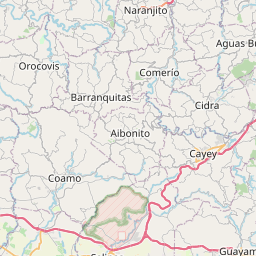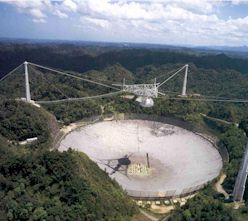Milestones:NAIC/Arecibo Radiotelescope, 1963
- Date Dedicated
- 2001-11-01
- Dedication #
- 41
- Location
- Arecibo, Puerto Rico
- IEEE Regions
- 9
- IEEE sections
- Puerto Rico & Caribbean
- Additional IEEE section information
- IEEE Milestone and ASME Landmark
- Achievement date range
- 1963
NAIC/Arecibo Radiotelescope, 1963
Arecibo, Puerto Rico, November 2001, IEEE Puerto Rico & Caribbean Section
(IEEE Milestone and ASME Landmark)
The Arecibo Observatory, the world's largest radiotelescope, was dedicated in 1963. Its design and implementation led to advances in the electrical engineering areas of antenna design, signal processing, and electronic instrumentation, and in the mechanical engineering areas of antenna suspension and drive systems. The drive system positions all active parts of the antenna with millimeter precision, regardless of temperature changes, enabling the telescope to maintain an accurate focus. Its subsequent operation led to advances in the scientific fields of radioastronomy, planetary studies, and space and atmospheric sciences.
The plaque is in the visitors' center at the Arecibo observatory, approximately 20 km south of Arecibo, Puerto Rico, at the end of road 625. However, because of the recent announcement by the National Science Foundation that the Arecibo observatory will be decommissioned, the visitors' center might be closed. Our understanding as of this writing (20 Nov. 2020) is that the plan is that the visitors' center will be preserved and reopened. Link to article on cause of collapse.
In order to use radio waves to explore space, scientists had to overcome one crucial obstacle: the weakness of cosmic signals. Cosmic radio signals are so weak, in fact, that all the energy collected by all the radio telescopes on our planet during the more than sixty-year history of radio astronomy amounts to no more than the energy released when a few raindrops hit the ground. An enormously sensitive collector of radio waves, such as the giant Arecibo radio-radar telescope, was needed to capture these signals. The Arecibo radar telescope was conceived by William E. Gordon, then a professor of electrical engineering at Cornell University. Gordon wanted to study the properties of the Earth's upper atmosphere, the ionosphere, and thought that he could use a radar system to measure the density and temperature in this difficult-to-study atmospheric region. His calculations indicated that an antenna approximately 305 meters (1,000 feet) in diameter would do the job, but would be far too expensive to build using existing designs for radio and radar antennas. To construct a telescope of the size he needed, Gordon hit on the idea of using a spherical, bowl-shaped reflector fixed in the ground, with a movable receiver hanging above it. This permitted the beam to point in a 20-degree range of directions around the zenith, or overhead direction. Such a telescope would be most useful in a location where the Sun, Moon, and planets pass almost directly overhead. Puerto Rico offered the extra advantage of Karst terrain-small, deep valleys surrounded by limestone hills-and a natural sinkhole south of the city of Arecibo provided an economical way to support the spherical reflector. Built in three years, the Arecibo Ionospheric Observatory began operations in 1963. Gordon's concept of using radar to study the ionosphere-called incoherent scatter radar-was successful. In addition, the telescope allowed radio measurements of a host of objects in the solar system, in our galaxy, and beyond. Arecibo Observatory is now part of the National Astronomy and Ionosphere Center (NAIC), a national research center operated by Cornell University under cooperative agreement with the National Science Foundation. The observatory is used by scientists from all parts of the United States and around the world.
With the completion in 1997 of the $25 million Gregorian reflector system suspended 137 meters (450 feet) above the telescope's 305-meter (1 ,000-foot) diameter dish, together with the construction of a ground screen and powerful new radar transmitter, the Arecibo telescope remains unmatched in its sensitivity and versatility for radio studies of the atmosphere, the solar system, and the universe.
Facts & Figures
- Arecibo Observatory sits on a 48-hectare (118-acre) site outside of the city of Arecibo, Puerto Rico. There are 140 staff members at the site, and another fifteen at NAIC headquarters on the Cornell University campus in Ithaca, New York.
- The observatory cost $9.3 million when it was completed in 1963. The 1974 upgrade cost another $9 million. The most recent upgrade completed in 1997, the addition of the Gregorian, a new radar transmitter, and ground screen cost $25 million. If the entire facility were to be built today, it would cost in excess of $100 million.
- More than 8 kilometers (five miles) of 2.5 cm. (1-inch)-thick steel cables and approximately 40 kilometers (25 miles) of 0.6 cm. (quarter-inch)-thick cables support the reflector. They keep it from changing shape as temperatures fluctuate and winds blow.
- The dish, 305 meters (1,000 feet) across, has a surface area of eighteen acres, the equivalent of 26 football fields.
- An on-site plant processed 270,000 kg (300 tons) of aluminum to fabricate the perforated panels that form the spherical surface. There are 38,778 of them, each measuring 101 cm. x 203 cm. (40 x 80 inches).
- Arecibo's azimuth arm is 93 meters (304 feet) long, 3.7 meters (12 feet) wide, and 10 meters (33) feet deep. It rotates on a circular track 42.7 meters (140 feet) in diameter.
- There are three towers supporting the structure. One is 111 meters (365 feet) high, and the other two are each 81 meters (265 feet) high. All three tops are at the same elevation.
- The 363 kilometers (227 miles) of aluminum angle used to make the frames supporting the main reflector panels could have made a guardrail all the way around the island of Puerto Rico.
- The dome that houses the Gregorian reflectors is six stories high, is suspended 137 meters (450 feet) above the main reflector, and, although made of aluminum to minimize its weight, still weighs 68,000 kg (75 tons).
Dedication Ceremony
Map













